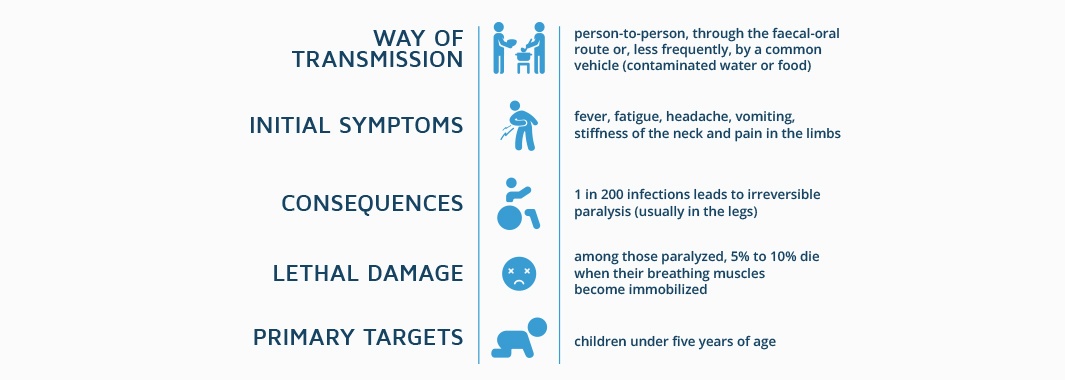Sitting on his mother’s knees in a hospital ward in Ukraine – Europe’s poorest developing country – two-year-old Misha laughs happily, holding a small ball in his right hand. The doctor who threw the ball smiles but his eyes are sad, just like the eyes of the boy’s mother. The reason for this sadness is that Misha cannot perform basic movements with the fingers of his left hand, he can barely walk and cannot remain in a sitting position. These are the consequences of poliomyelitis – one of the worst diagnoses a parent could ever hear. With significant progress in preventing this disease, and the recently announced eradication of two out of the three wild-polio strains after years of struggle, the international community cannot afford to relax in its efforts to eradicate the virus. Why is the disease so dangerous and what has the international community done to fight the virus? You can find out in this article.
Poliomyelitis is a highly infectious viral disease that attacks the nervous system. Children under five years of age are most vulnerable to the virus. It can cause total paralysis in a matter of hours.

Nobody has discovered the cure for poliomyelitis. It can only be prevented by multiple administration of the polio vaccine – a solution that can protect the child for life. In this sense, the international community has achieved great results – the World Health Organization (WHO) reported recently that, among the three individual wild poliovirus strains, type 2 (WPV2) and type 3 (WPV2) are considered to be eradicated worldwide, while type 1 (WPV1) is still at large.
The effects of all three strains are identical in that they cause irreversible paralysis or even death. However, there are genetic and virologic differences which cause these three strains to be three separate viruses which must each be eradicated individually, according to WHO experts.
The good news is that, on October 24th, 2019 – World Polio Day, an independent commission of experts announced that wild poliovirus type 3 (WPV3) had been eradicated worldwide, with the last case of infection detected in northern Nigeria in 2012. Since then, no reports of the existence of WPV3 anywhere in the world have been encountered. Following the eradication of smallpox and wild poliovirus type 2, this news represents a historic achievement for humanity. The news is also an important and inspiring message to the world, after the raising of awareness of a worsening climate and other challenges announced during the September 2019 UN Summit in New York, USA.
The evolution of poliomyelitis
Since 1988, when 350,000 people in 125 countries died because of the poliovirus, major progress has been achieved in fighting the disease. Thus, 12 years later, in 2000, the number of infected people had decreased to 2,971 in just 20 countries. The number of countries with registered polio infections dropped steadily to 16 in 2005, then eight countries in 2013 and finally two countries – Pakistan and Afghanistan – last year. The World Health Organization report concludes that only 33 wild polio cases were encountered in 2018 in these two Asian countries.

However, there are still ‘vaccine-derived’ polioviruses which are periodically registered across the world. These viruses are excreted by the vaccinated human organism. If the community where the vaccine-derived virus is excreted is seriously under-immunized, it can continue to circulate.
Remember Misha from Ukraine? This is how he become infected. There are cases of vaccine-derived polio infected children across the world, in regions like Africa and Indonesia, and that is why the international community is urged not to stop the efforts to eradicate polio now.
The costs of fighting wild polio
The Global Polio Eradication Initiative (GPEI) which is the flagship of humanity’s battle against poliomyelitis reported that, between 1988 and 2018, over US$16 billion had been provided by over 100 public and private donors for activities to seek the eradication of polio. As a result, 16 million people can walk instead of being paralyzed by the virus and 1.5 million people are still alive.
At the same time, according to the WHO, the worldwide polio eradication measures have saved the international community more than US$27 billion in health costs since 1988. The same voices say that a sustained polio-free world will generate a further US$14 billion in savings by 2050, compared to the cost that countries would incur in controlling the virus indefinitely.
This amount can therefore be funneled to other measures in health or related sectors.
Developing countries, assisted by the international development community, have implemented national immunization programs – the key to a successful fight against wild polio.
With only WPV1 still at large in Pakistan and Afghanistan, a polio-free world is achievable. The key to success will be the ongoing commitment of the international development community.
“We cannot stop our efforts now: we must eradicate all remaining strains of all polioviruses. We do have good news from Africa: no wild poliovirus type 1 has been detected anywhere on the continent since 2016 in the face of ever improving surveillance. Although the region is affected by circulating vaccine-derived polioviruses, which must urgently be stopped, it does appear as if the continent is free of all wild polioviruses, a tremendous achievement.” said Professor David Salisbury, chair of the independent Global Commission for the Certification of Poliomyelitis Eradication.
Do you feel your experience may be useful for the International Development Sector in addressing issues such as polio eradication? Become a DevelopmentAid member and get involved in international development projects.

